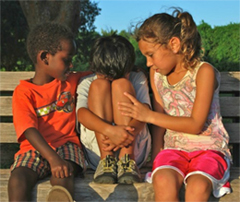Thursday, 20 April 2017
Learning Empathy

The existence of empathy and altruistic behaviour among various species of animals has been amply demonstrated. Among elephants, examples include comforting members of the herd who are frightened, rescuing others when they get get stuck in mud holes, and adopting orphaned babies. Chimpanzees and bonobos display sophisticated altruistic behaviours in dealing with weak or disabled members of their troops, trying to help them stand, bringing them food, and covering them with vegetation after confirming that they have died.
The human species is no exception. We human beings depend so much on one another and our societies are so complex that our ability to put ourselves in someone else’s shoes, to feel what they are feeling and to act accordingly, is quite obvious. Ethologists and evolutionary biologists agree that in species that form complex societies in which cooperation and mutual assistance constitute an advantage for the entire group, empathy developed naturally.
But there’s no denying that some people are more empathetic than others, which raises the question: can empathy be learned? Considering all the suffering and conflict caused by lack of empathy, this is no trivial question. Happily, several recent studies by cognitive neuroscientists seem to show that the ability to empathize can in fact be acquired.
One such study was published by Grit Hein and her colleagues in the Proceedings of the National Academy of Sciences of the United States of America in January 2016. Entitled “How learning shapes the empathic brain”, the study’s point of departure was a well known phenomenon: when people observe the suffering of others whom they do not consider part of their own social group, the empathy-related responses of their brain networks are limited. The question that Hein and her colleagues investigated was whether these responses could be increased through a learning process.
In Hein’s study, the subjects had to perform a task in which they received assistance either from members of their own social group or from members of an “out-group”. In the latter case, the subjects displayed a classic signal of learning, known as the “prediction error”, in their anterior cingulate cortex. In effect, when a stranger was kind to the subjects and helped them, things were not going as they had expected, and so their brain was telling them that their basic attitude was erroneous.
Subsequently, the subjects who had undergone this experience displayed greater empathy-related brain responses, not only toward the out-group members who had helped them, but also toward other members of the out-group as a whole. Clearly, these subjects had learned that these other people were basically good folks. Another especially interesting finding of this study was that this generalization of empathy toward other members of the out-group occurred very quickly, after just a few positive interactions in the experiment.
Other studies have looked at empathy-related brain responses when people are reading novels, a solitary activity that at first glance would seem to have little to do with empathy. It turns out that readers’ brains treat the interactions among fictional characters exactly as if they were occurring among real people. Many studies have shown that imagining something activates the same sensory areas of the cortex as actually perceiving it, and reading is just a particular example of this broader phenomenon.
Studies conducted by psychologists such as Raymond A. Mar, Keith Oatley and Jordan B. Peterson since 2006 have shown that both male and female readers of fiction seem to be better at understanding other people, at experiencing empathy for them, and at seeing the world from their point of view. In 2010, Mar observed the same pattern in pre-school-age children: the more stories that were read to them, the better able they were to put themselves in someone else’s shoes.
Lastly, in 2013, Gregory S. Berns and his colleagues explored the neurobiological bases of this phenomenon. Berns’s research team used a functional magnetic resonance imaging (fMRI) scanner to observe the brain connectivity patterns of 21 subjects before, during and after a nine-day period when they all read a novel about the destruction of the city of Pompeii by the volcano Mt. Vesuvius. What the scientists found was an increase in connectivity between two parts of the brain that had previously been shown to be associated with understanding a story and taking another person’s perspective: the left supramarginal angular gyrus and the right posterior temporal gyrus.
So what can we conclude from all this? At the very least, that the next time your kids want to just watch TV or play a video game, you might suggest that instead, they go read a story, or go out and play with some kids from a different social or ethnic group.
![]() How learning shapes the empathic brain
How learning shapes the empathic brain
Pleasure and Pain | No comments







